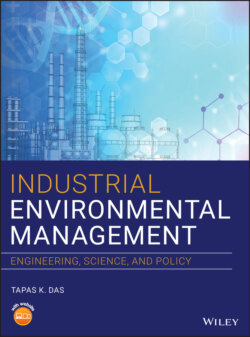Читать книгу Industrial Environmental Management - Tapas K. Das - Страница 32
1.10.3 Build Industrial Clusters
ОглавлениеIn sectors that cannot achieve Zero Emissions unilaterally, it may be necessary to build industrial clusters. The input–output analysis leads directly into development of clusters of industries that can use each other's outputs. Developing effective clusters calls for executives look beyond single industries and make innovative connections among seemingly unrelated potential partners in new industrial clusters. Companies are loathe to implement such changes, however. In addition to concerns about antitrust regulations, and the need to rely on single vendors for supply, there is fear that relinquishing information about waste stream composition will allow their competitors to deduce proprietary secrets.
Also critical is the geographic location of the client's potential partners, as transportation is a key factor in optimizing waste exchange and use of conversion technologies. The most obvious link in the search for industrial cluster partners will be obtaining industrial input data for other industrial sectors and determining if the client's waste flows could serve (in some converted form) as a material input to another sector. The second place to look for candidate industrial clusters is the historical records of waste exchanges. These material flows will demonstrate which materials being discarded by a sector are of a volume and quality desirable to another sector.
Industries that buy process wastes are taking in nonvirgin material of a grade that may fall short of the purchasers' specification. This is an opportunity for materials blending. For example, plastics can be recycled to make a lumber‐like product, but the grade of such recycled products is not always acceptable as a direct input. If a contaminated waste flow is not of sufficient volume, however, blending in virgin plastics can bring both quality and volume up to manufacturing specifications.
Once the potential partners have been identified, the industrial cluster should be designed and developed. Kalundborg (Grann 1994) is an excellent example of a cluster that includes heavy industries, while Tsumeb's cluster is based primarily around food production and processing. Elsewhere in the world, industrial cluster is yet to be developed.
India and China are industrializing nations that have abundant and cheap supplies of coal, but burning it to generate electricity produces CO2, SO x , and NO x . The key to sustainability for industrializing countries will therefore be development of industrial clusters that link energy, agriculture, and sewage treatment, in the fundamental format for Zero Emission communities. The most effective incentive to develop such clusters is economics, and, unlike conventional SO x and NO x treatments, the system for the electron beam/ammonia conversation of these pollutant has a financial payback of 10–15 years. Section 9.2.3 treats this technology in more detail.
